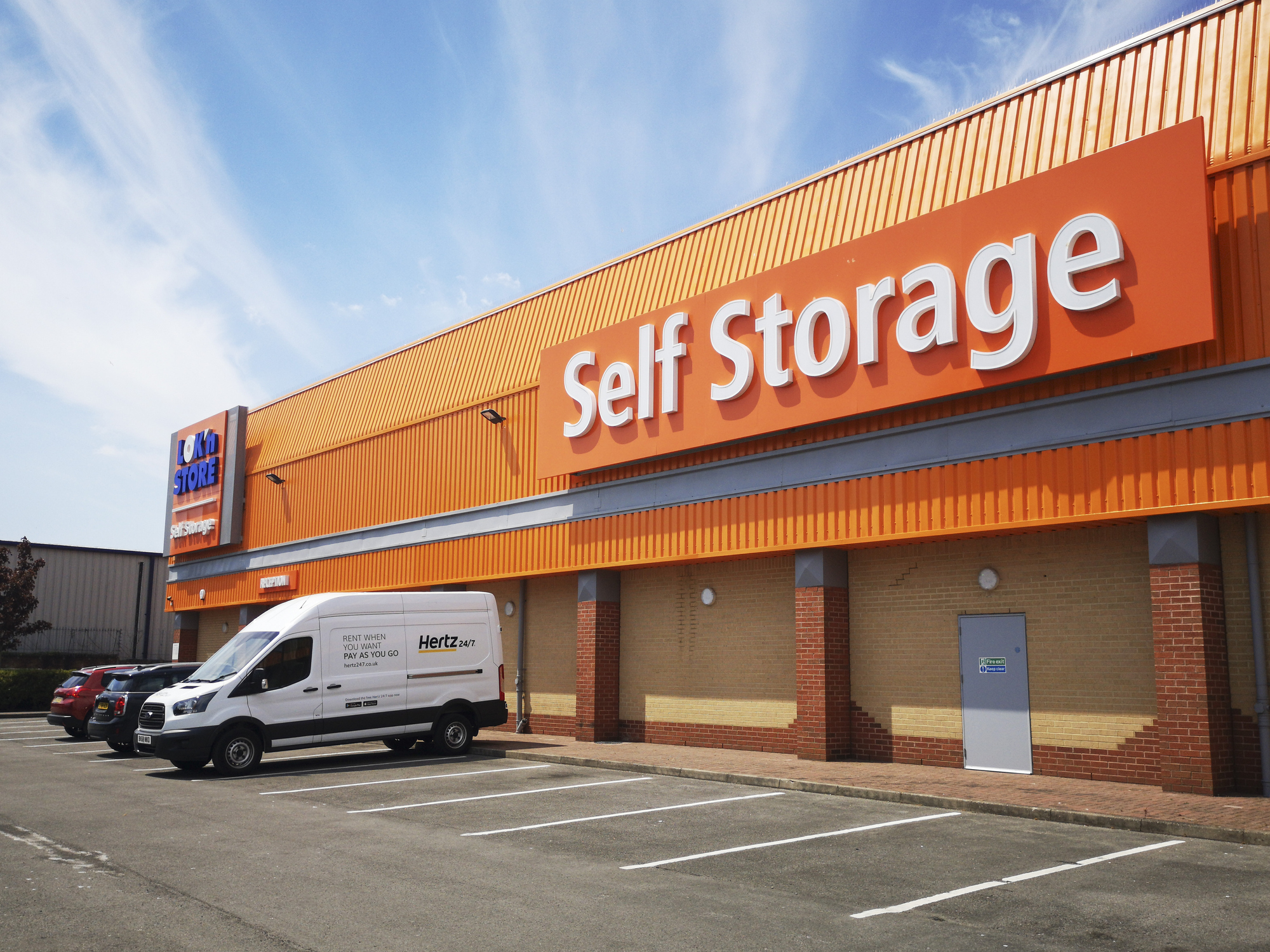The Evolution of Self Storage:
From the 1960s to Today
Self-storage evolution began in the 1960s with basic garage-style units in Texas and has transformed into today’s AI-powered, climate-controlled facilities serving over 14.5 million American households. The industry metamorphosis reflects broader societal changes, including suburbanization, consumer culture growth, technological advancement, and shifting lifestyle demands that have shaped how Americans store and manage their possessions over six decades.
As someone who has witnessed countless businesses adapt to changing storage needs through my two decades at Complete Controller, I’ve observed firsthand how self-storage has grown from a niche solution to essential infrastructure supporting modern American life. The industry now generates over $44 billion annually and maintains 36% average profit margins compared to just 22% for all other industries. This remarkable evolution reveals crucial insights about American consumer behavior, urban development, and technological innovation that every business owner should understand.

What is self-storage evolution, and why does it matter?
- Self-storage evolution encompasses the transformation from basic 1960s storage sheds to sophisticated, technology-integrated facilities serving diverse consumer and business needs
- The industry grew from addressing post-WWII suburbanization storage needs to supporting modern urbanization, e-commerce, and mobile lifestyle demands
- Technological integration has revolutionized access, security, and management through AI surveillance, mobile apps, and automated systems
- Market expansion reflects changing demographics, with facilities evolving from simple storage to comprehensive lifestyle support services
- Future developments focus on sustainability, digital integration, and specialized storage solutions for emerging consumer segments
The Genesis of Modern Self-Storage in the 1960s
The modern self-storage industry emerged in the late 1960s as a direct response to post-World War II societal transformations, which created unprecedented demand for additional storage space. Land speculators in Texas recognized an opportunity to monetize undeveloped parcels by constructing simple steel buildings that could generate revenue while awaiting future development. These pioneering entrepreneurs understood that rapid suburbanization and the burgeoning consumer culture were creating storage challenges that traditional housing couldn’t address.
The first self-storage facilities, initially called “mini warehousing,” opened in Texas during this period, capitalizing on a unique regional factor that made the concept particularly viable. Most Texas homes lacked basements, which in other regions typically served as primary household storage areas, creating an immediate market need for external storage solutions. This geographical advantage allowed Texas-based operators to test and refine their business models before expanding to other markets where basement storage was more common.
Early business model development
The initial self-storage business model focused primarily on small businesses rather than residential customers, as entrepreneurs recognized that commercial enterprises needed flexible, affordable alternatives to expensive warehouse space. By 1979, approximately 3,500 mini warehouses operated nationwide, demonstrating the concept’s rapid market acceptance and scalability potential. These early facilities typically featured basic construction with minimal amenities, focusing on functionality and affordability rather than the comprehensive service offerings that would emerge in later decades.
Explosive Growth and Industry Standardization
The 1970s marked a pivotal transformation period when self-storage evolved from a regional Texas phenomenon to a nationwide industry experiencing unprecedented growth and sophisticated business development. Entrepreneurial pioneers like Wayne Hughes and Ken Volk recognized the enormous potential in creating purpose-built storage facilities equipped with various unit sizes and modern security features. Their vision encompassed understanding changing American lifestyles, particularly increasing mobility and the desire for flexible storage solutions that could adapt to evolving consumer needs.
Hughes and Volk’s Public Storage company exemplified innovative growth strategies by refusing traditional debt financing. Instead, Hughes raised over $3 billion through real estate limited partnerships, allowing rapid expansion while maintaining financial flexibility. Their first facility broke even with just 35% occupancy within three months, proving the business model’s viability. Today, Public Storage operates nearly 2,500 facilities across 38 states, demonstrating how innovative financing and strategic location selection created industry dominance.
International expansion begins
The industry’s success in America soon attracted international attention, leading to the first European self-storage facility opening in central London in 1979. Abbey Self-Storage became the foundation for the first self-storage chain in Europe and established the template for international expansion. The European market required significant adaptation to different cultural attitudes toward personal space and storage needs.
Economic conditions in the 1970s, including the oil crisis, inadvertently accelerated industry growth as many Americans were forced to downsize their homes and required external storage. By the 1990s, facilities began offering advanced services including 24-hour access capabilities, comprehensive security systems, and climate-controlled units designed to attract more customers. This standardization played a fundamental role in facilitating global industry expansion.

Revolutionary Technology Integration
The integration of advanced technology has fundamentally transformed self-storage operations from basic storage provision to sophisticated, data-driven service delivery. Modern facilities leverage artificial intelligence, Internet of Things devices, and cloud-based management systems to optimize everything from inventory management to customer communication. This technological revolution has enabled property owners to dramatically reduce manual labor requirements while simultaneously increasing productivity.
Self-service kiosks represent one of the most visible technological innovations, allowing customers to rent units, sign leases, purchase insurance, access digital keys, and process payments without requiring on-site staff assistance. These systems integrate with backend management platforms that provide real-time analytics for improved decision-making. The elimination of manual paperwork has reduced operational costs while enhancing customer convenience through 24/7 facility access.
AI-powered security advances
Artificial intelligence has emerged as a transformative force in modern self-storage operations, enabling large-scale data analysis that provides valuable insights into demand trends and optimal pricing strategies. AI-powered video surveillance systems now provide 24/7 monitoring with advanced features including facial recognition and object detection, offering proactive security approaches designed to deter intruders before incidents occur.
Internet of Things technology has created new possibilities by enabling comprehensive environmental monitoring and remote access management. Smart locks and sensors provide real-time unit monitoring capabilities while mobile applications allow customers to manage their storage units and process payments from anywhere. This connectivity has transformed the customer experience by providing unprecedented convenience and control.
Market Expansion and Urbanization Impact
Urbanization has emerged as a primary driver of self-storage demand, fundamentally reshaping the industry’s customer base to accommodate modern city living challenges. Urban housing trends toward smaller apartments have created unprecedented demand for external storage solutions, as rising real estate costs force residents into compact living spaces. The combination of limited residential storage capacity and higher population density has established self-storage as essential urban infrastructure.
The highly mobile nature of urban workforces has accelerated demand for flexible storage solutions, as professionals frequently relocate for employment opportunities or lifestyle changes. Small business owners and online retailers increasingly use storage units to house inventory, allowing them to operate efficiently without expensive commercial rent costs. This business-focused utilization has driven demand for larger units and specialized services supporting commercial operations.
Regional growth patterns
Analysis of current market data reveals that Sunbelt and Western cities are experiencing the most dramatic growth in storage demand, driven by rapid population increases and shrinking housing footprints. Cities like Baton Rouge, Miami, and Orlando lead national rankings for storage-related online searches, reflecting intense local demand. Florida markets exemplify complex factors driving regional storage needs, including dense urban conditions and seasonal population fluctuations.
Current Trends and Future Outlook
The contemporary self storage industry faces a complex landscape characterized by unprecedented growth opportunities alongside operational challenges reshaping business strategies. Construction spending on self-storage facilities increased by 584% over five years, reaching a record $6.99 billion in 2023. This expansion has created competitive pressures forcing operators to differentiate through enhanced services and technological innovation.
Despite oversupply concerns in some regions, fundamental demand drivers remain robust. The industry’s evolution toward institutional investment has attracted private equity groups recognizing self-storage’s potential for consistent returns. This investment influx has accelerated professional management practices and technological adoption while intensifying competition among operators seeking market share.
Sustainability and innovation focus
Environmental sustainability has become a critical focus for modern facilities incorporating solar panels, energy-efficient lighting, and eco-friendly construction materials. Future developments emphasize smart building technologies that optimize energy consumption while maintaining ideal storage conditions. The integration of renewable energy sources positions self-storage facilities as environmentally responsible community partners.
Conclusion
The evolution of self-storage from simple 1960s warehouses to today’s technology-driven facilities represents one of American business’s most remarkable transformation stories. Through my work at Complete Controller, I’ve seen how businesses leverage modern self-storage solutions to support growth, manage inventory, and adapt to changing market conditions. The industry’s journey from 3,500 facilities in 1979 to over 52,000 today demonstrates entrepreneurial vision meeting genuine market needs.
Looking ahead, the convergence of artificial intelligence, sustainability initiatives, and evolving consumer expectations promises continued innovation in self-storage solutions. Smart facilities offering personalized services, predictive maintenance, and seamless digital experiences will define the next chapter of industry evolution. For business owners seeking flexible, cost-effective storage solutions that grow with their needs, understanding this evolution helps them make informed decisions about leveraging modern self-storage advantages.
Ready to optimize your business operations with smart storage solutions? Contact the experts at Complete Controller for comprehensive guidance on financial strategies that support your growth, including maximizing tax benefits from business storage expenses and operational efficiency improvements.

Frequently Asked Questions About Self Storage Evolution
When did the modern self-storage industry actually begin?
The modern self-storage industry began in the late 1960s in Texas, where entrepreneurs converted simple steel buildings into rentable storage units. The concept grew from addressing the unique challenge that most Texas homes lacked basements, creating immediate demand for external storage solutions.
How has technology changed the self-storage experience for customers?
Technology has revolutionized self-storage through self-service kiosks, enabling 24/7 unit rental, mobile apps for remote account management, AI-powered security systems with facial recognition, and IoT sensors monitoring climate conditions. These innovations have eliminated the need for on-site staff while providing superior customer convenience.
What drove the massive growth of self-storage from the 1970s to today?
Multiple factors fueled growth including suburbanization creating larger households with more possessions, economic pressures forcing home downsizing, increasing workforce mobility requiring temporary storage, and the rise of small businesses needing affordable warehouse alternatives. The industry grew from 3,500 facilities in 1979 to over 52,000 today.
Which regions are experiencing the fastest self-storage market growth?
Sunbelt and Western cities lead growth, with markets like Baton Rouge, Miami, Orlando, and Boise showing highest demand. Florida exemplifies intense market conditions due to dense urban living, seasonal population changes, and limited residential storage driving competition for available units.
What does the future hold for self-storage innovation?
The future includes expanded AI integration for predictive analytics and automated operations, sustainability features like solar power and eco-friendly construction, specialized storage for emerging needs like e-commerce fulfillment, and enhanced digital experiences through virtual reality tours and blockchain-secured smart contracts.
Sources
- Alan’s Factory Outlet. (2024). “54 Self-Storage Industry Statistics to Know in 2024.” https://alansfactoryoutlet.com/blog/self-storage-industry-statistics/
- EnvZone. “The Spectacular Rise of Public Storage Giant.” https://envzone.com/the-spectacular-rise-of-public-storage-giant-success-started-small/
- Funding Universe. “History of Public Storage, Inc.” https://www.fundinguniverse.com/company-histories/public-storage-inc-history/
- IBM Cloud Education. “What is Artificial Intelligence (AI)?” https://www.ibm.com/cloud/learn/what-is-ai
- National Institute of Standards and Technology. “Biometrics.” https://www.nist.gov/programs-projects/biometrics
- Neighbor Blog. (2024). “Self Storage Industry Statistics (2024).” https://www.neighbor.com/storage-blog/self-storage-industry-statistics/
- ReBusiness Online. “A Short History of the Self Storage Industry.” https://rebusinessonline.com/a-short-history-of-the-self-storage-industry/
- Self Storage Association. (2024). “Industry Data and Statistics.” https://www.selfstorage.org/LinkClick.aspx
- U.S. Census Bureau. “Population and Housing Statistics.” https://www.census.gov
 About Complete Controller® – America’s Bookkeeping Experts Complete Controller is the Nation’s Leader in virtual bookkeeping, providing service to businesses and households alike. Utilizing Complete Controller’s technology, clients gain access to a cloud platform where their QuickBooks™️ file, critical financial documents, and back-office tools are hosted in an efficient SSO environment. Complete Controller’s team of certified US-based accounting professionals provide bookkeeping, record storage, performance reporting, and controller services including training, cash-flow management, budgeting and forecasting, process and controls advisement, and bill-pay. With flat-rate service plans, Complete Controller is the most cost-effective expert accounting solution for business, family-office, trusts, and households of any size or complexity.
About Complete Controller® – America’s Bookkeeping Experts Complete Controller is the Nation’s Leader in virtual bookkeeping, providing service to businesses and households alike. Utilizing Complete Controller’s technology, clients gain access to a cloud platform where their QuickBooks™️ file, critical financial documents, and back-office tools are hosted in an efficient SSO environment. Complete Controller’s team of certified US-based accounting professionals provide bookkeeping, record storage, performance reporting, and controller services including training, cash-flow management, budgeting and forecasting, process and controls advisement, and bill-pay. With flat-rate service plans, Complete Controller is the most cost-effective expert accounting solution for business, family-office, trusts, and households of any size or complexity.
 Reviewed By:
Reviewed By:














